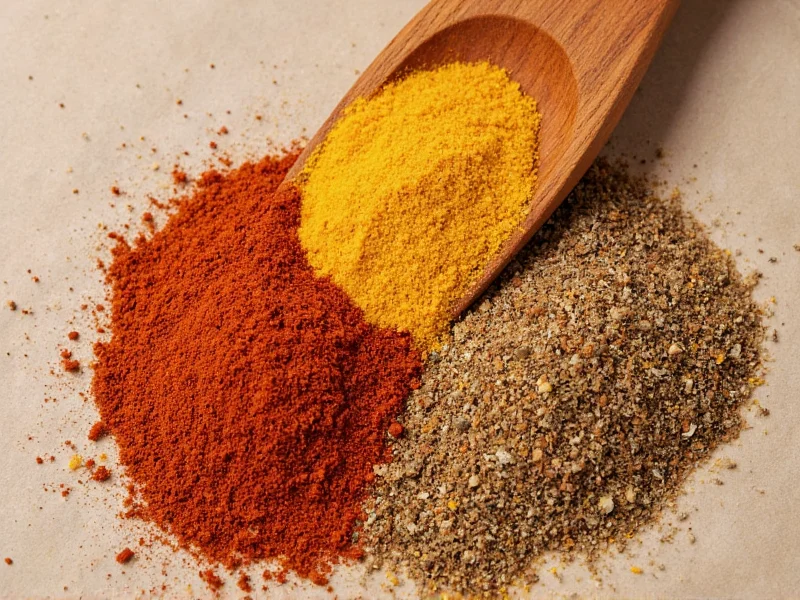Southwest seasoning brings the vibrant flavors of the American Southwest to your kitchen. This versatile spice blend captures the essence of regional cuisine with its perfect balance of earthy, smoky, and mildly spicy notes. Creating your own mix ensures freshness, avoids additives found in commercial versions, and allows customization to your taste preferences.
Complete Southwest Seasoning Mix Recipe
Making your own southwest seasoning mix takes just minutes and requires common pantry staples. This recipe yields approximately 6 tablespoons, enough to season multiple dishes.
Ingredients
- 2 tablespoons chili powder (key southwest seasoning mix ingredient)
- 1 tablespoon ground cumin (essential for authentic southwest flavor)
- 1 tablespoon garlic powder
- 1 tablespoon onion powder
- 1 tablespoon smoked paprika (for depth in homemade southwest seasoning)
- 1 teaspoon dried oregano
- 1/2 teaspoon cayenne pepper (adjust for heat preference)
- 1 teaspoon sea salt (optional)
- 1/2 teaspoon black pepper
Preparation Instructions
- Combine all ingredients in a small bowl.
- Whisk thoroughly until uniformly colored.
- Transfer to an airtight container.
- Store in a cool, dark place away from heat sources.
| Ingredient | Flavor Contribution | Substitution Options |
|---|---|---|
| Chili powder | Earthy base note | Ancho chili powder for smokiness |
| Cumin | Distinctive southwest earthiness | Coriander (milder alternative) |
| Smoked paprika | Smoky depth | Regular paprika + pinch of liquid smoke |
| Cayenne | Controlled heat | Red pepper flakes (use sparingly) |
Understanding Southwest Seasoning Components
Each component in your homemade southwest seasoning mix serves a specific purpose in creating the complex flavor profile characteristic of Southwestern cuisine. Chili powder forms the foundation, while cumin provides that unmistakable earthy note essential to authentic southwest seasoning. Smoked paprika adds dimension that regular paprika can't match—this distinction matters when creating truly authentic homemade southwest seasoning.
For the best results, use fresh spices. Ground spices lose potency over time, so check your pantry staples before making your southwest seasoning blend. If your cumin smells faint or paprika has lost its vibrant color, replace them before creating your mix. This attention to ingredient quality separates adequate blends from exceptional ones.
Practical Applications for Your Seasoning Mix
This versatile blend enhances numerous dishes beyond the obvious taco applications. Use 1-2 tablespoons per pound of:
- Proteins: Chicken, beef, pork, shrimp, or tofu (as dry rub before cooking)
- Vegetables: Roasted sweet potatoes, corn, or bell peppers
- Legumes: Black beans, pinto beans, or lentils
- Liquids: Stir into soups, stews, or tomato-based sauces
For marinades, combine 2 tablespoons of your southwest seasoning mix with 1/4 cup olive oil and 2 tablespoons lime juice. Let proteins marinate for 30 minutes to 2 hours before cooking. When using in wet applications like soups, add the seasoning during the last 15 minutes of cooking to preserve flavor integrity.
Customizing Your Southwest Blend
The beauty of homemade southwest seasoning mix lies in its adaptability. Consider these modifications based on your preferences:
- For milder flavor: Reduce cayenne to 1/4 teaspoon or omit entirely
- For smokier profile: Increase smoked paprika to 1.5 tablespoons
- Salt-free version: Omit salt and add 1/2 teaspoon celery seed
- For Tex-Mex variation: Add 1/2 teaspoon dried cilantro
- For Arizona-inspired blend: Include 1/4 teaspoon dried juniper berries (finely ground)
When adjusting recipes, modify one ingredient at a time to understand its impact. Keep notes on your variations—this helps recreate successful blends and avoid less appealing combinations. Remember that spice potency varies by brand, so taste as you adjust your southwest seasoning recipe.
Storage Guidelines for Maximum Freshness
Proper storage maintains your southwest seasoning mix's potency. Follow these guidelines:
- Use glass or metal containers with tight-fitting lids (avoid plastic)
- Store away from stove, oven, or direct sunlight
- Label with creation date
- For extended storage, keep in refrigerator (up to 9 months)
- Freeze for longest shelf life (up to 1 year)
Your homemade southwest seasoning has passed its prime when colors fade significantly or the aroma becomes faint. Properly stored, it maintains optimal flavor for 4-6 months at room temperature. For best results, make smaller batches you'll use within 3 months.
Troubleshooting Common Issues
Even simple spice blends can present challenges. Here's how to address common problems with your southwest seasoning mix:
- Too spicy: Balance with additional paprika or a pinch of sugar
- Too bland: Add small increments of cumin or cayenne (1/8 teaspoon at a time)
- Clumping: Ensure all ingredients are completely dry; add 1-2 grains of raw rice to container
- Flavor imbalance: Let the mixed seasoning rest for 24 hours before final assessment
Remember that spice blends often taste different when incorporated into finished dishes versus when sampled alone. Always test your southwest seasoning mix in a small portion of food before adjusting the entire batch.
Comparing Homemade vs. Store-Bought
While convenient, commercial southwest seasoning blends often contain anti-caking agents, excess salt, and inconsistent spice ratios. Making your own offers distinct advantages:
- Control over sodium content (important for dietary restrictions)
- Fresher flavor profile (commercial blends lose potency during shipping)
- Ability to customize heat level and flavor balance
- No mysterious "spice blends" or unidentifiable ingredients
- Cost savings over time (homemade costs approximately $0.25 per ounce vs. $0.75+ for store versions)
When evaluating store-bought southwest seasoning mix options, check for ingredient transparency and avoid products listing "spices" as a single ingredient. The best commercial blends specify each component, though they still can't match the freshness of homemade versions.











 浙公网安备
33010002000092号
浙公网安备
33010002000092号 浙B2-20120091-4
浙B2-20120091-4